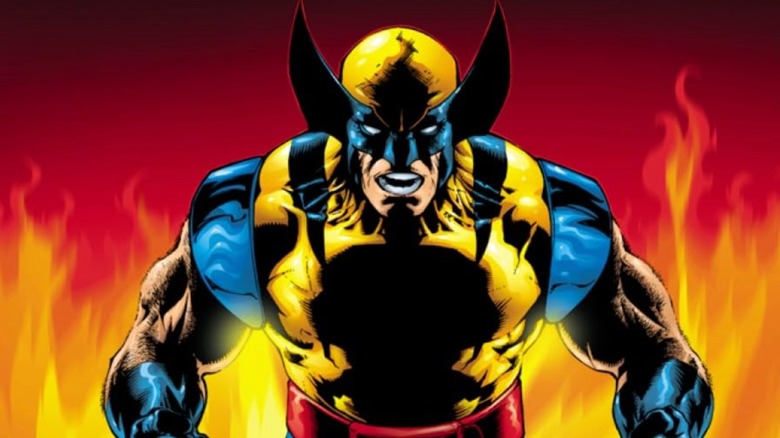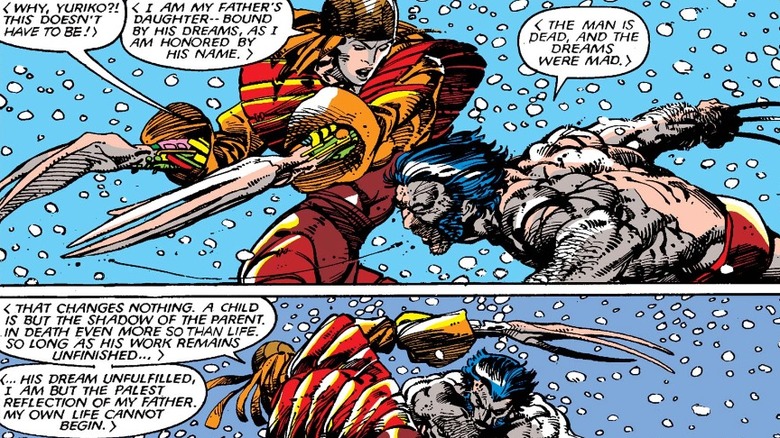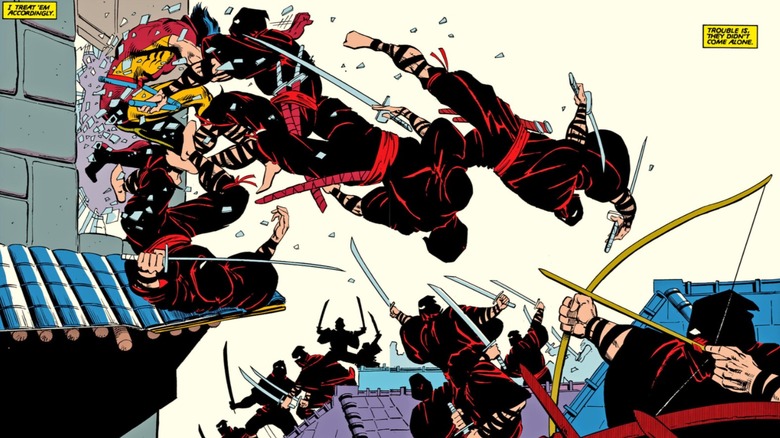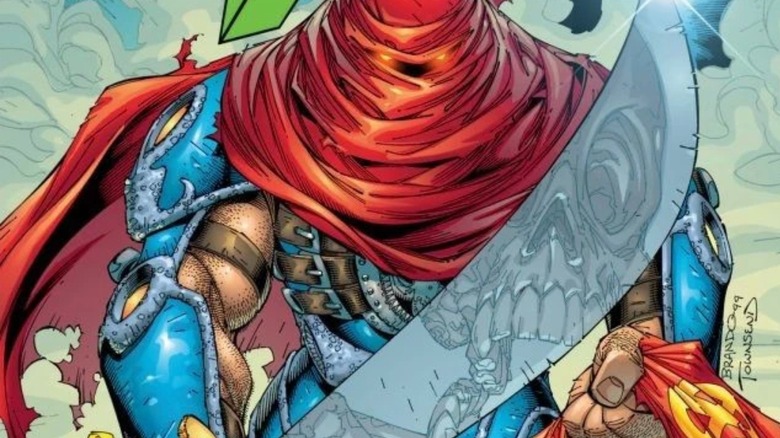This Unmade X-Men Comic Book Would've Given Wolverine A Wild Twist
Chris Claremont wrote the X-Men comics from 1975 to 1991, but he could've — and would've — gone even longer. Marvel Editor Bob Harras, though, was giving more and more power to artist Jim Lee, to the point Claremont was basically just writing the dialogue for Lee's stories. After building the X-Men from the ground-up and spending a decade-plus with the characters, having his comic hijacked like that had to sting. Thus, Claremont departed after "Uncanny X-Men" #279. He's returned to the X-Men several times since, but the last stories of his unbroken run were the first three issues of the relaunched 1991 comic simply titled "X-Men."
Had Claremont stayed on, he had plans for stories at least up to "Uncanny X-Men" #300. He was building up to an arc where the malevolent psychic the Shadow King manipulates man and mutant kinds into all-out war. Claremont also wanted to permanently write out, if not kill, Professor X and commit to Magneto's redemption by having Magnus take his friend's place as the X-Men's headmaster.
"Magneto is so much more interesting a character [than Xavier], especially as a headmaster, because he has so much more to lose," Claremont said. You can see this proven true in Claremont's "New Mutants" and the cartoon "X-Men '97," where Magneto fills in as leader of the absent Professor X's pupils.
Claremont had already attempted this Xavier/Magnus swap once in "Uncanny X-Men" #200, but the editorial mandated some backtracking. While Claremont wanted Magneto as an anti-hero, he had more sinister plans for one of the X-Men's greatest heroes. If Claremont had kept writing the X-Men, Wolverine would've died and returned as a villain. Claremont told Inverse in 2022 that he'd been worried about Wolverine "burnout" — he'd even fought against giving Wolverine a solo series in 1988. Turning the X-Men's most popular hero into an adversary was evidently his plan to forestall that burnout.
Lady Deathstrike would have finally killed Wolverine
Claremont has talked about his unrealized plans for an evil Logan in many interviews over the years, such as with the now defunct Wizard Magazine or in more recent sit downs with comic YouTubers. X-Men fans have sometimes dubbed this unrealized story "The Dark Wolverine Saga," in the style of Claremont's most famous X-Men tale, "The Dark Phoenix Saga," also about a hero (Jean Grey) gone rogue.
Some context for where the X-Men were when Claremont departed, courtesy of the "Amazing Heroes" comic magazine. Issue #188, published in 1991, includes a promotional feature about the coming year of X-Men comics. Issue #192 features interviews with Claremont and Lee about their plans.
As did ultimately happen, the X-Men would be divided across two teams, both having their own book. "Uncanny X-Men" would star the Gold Team (Storm, Jean Grey, Iceman, Colossus, Archangel, and Bishop), "X-Men" would star the Blue Team (Cyclops, Wolverine, Rogue, Gambit, Beast, Psylocke, and Jubilee). The initial plan was that Whilce Portacio would draw "Uncanny X-Men," Jim Lee would draw "X-Men," and Claremont would write both. That last part was short-lived.
Claremont's plan, revealed in a Wizard interview, was for Wolverine to die in "X-Men" #3. It wouldn't be an out-of-nowhere death either. Do you remember the crucified Wolverine variant in "Deadpool & Wolverine"? That image is taken from the cover of "Uncanny X-Men" #251 (drawn by Marc Silvestri), where Wolverine is captured, tortured, and crucified by Lady Deathstrike and the Reavers. Claremont had intended that the torture broke Wolverine's healing factor; he was dying and out to "settle old debts." Deathstrike had sworn a vendetta against Wolverine about 100 issues ago for "stealing" the adamantium her father had created. In their final battle, she'd fulfill her vow by tearing out Logan's heart and finally killing him. But that wouldn't be the end.
Chris Claremont wanted to make Wolverine into an agent of the Hand
Wolverine's body would go missing after his fatal duel with Deathstrike and, soon thereafter, it'd be revealed that some of Logan's old enemies had taken it. Which ones? The Hand, Marvel's cult of undead ninjas.
Frank Miller created the Hand as recurring villains during his run on "Daredevil." They were depicted as resurrecting dead warriors and in the process brainwashing them into loyal assassins. This is how Elektra returned to life in "Daredevil" #190, but Daredevil's love purified her soul.
Miller drew Claremont's 1982 "Wolverine" mini-series, set in Japan, and reused the Hand as villains, establishing their connections to Logan. In the next few unwritten issues of Claremont's "X-Men"/"Uncanny X-Men" the Hand would return with a new clawed assassin, that of course being the brainwashed Logan. Like Claremont's other unrealized plan of revealing Sabretooth as Wolverine's father, this story would've emphasized the split in Logan's soul between man and beast.
Wolverine would remain a villain for about a year of publication, fighting both teams of the X-Men in both titles. Claremont foresaw a battle between Wolverine and Colossus where the latter tears out Wolverine's claws, causing the adamantium to slowly be purged from his body altogether. (Claremont even envisioned a cover for this unmade issue, with a black background and spotlight showing the disembodied claws.)
The X-Men would be split on whether to save or kill their brainwashed friend, with Jean advocating for saving him. She would infiltrate The Hand to do so, unaware that Logan was merely the bait to lure her in so the Hand could tame the Phoenix. Of course, Logan and Jean would eventually be freed from the Hand and even get together afterwards. The two of them would realize, Claremont said, that while their other lovers will die one day, Jean (as the Phoenix) and Logan (thanks to his healing factor) are both immortal.
Marvel editorial did not accept Claremont's pitch. For one, it would've put Larry Hama (who was writing the solo "Wolverine" comic) in an awkward position. Hama asked Claremont, the latter recalled, what he was supposed to write for the year while Logan was a villain.
However, some of Claremont's "Dark Wolverine" plans would be echoed in the near future.
Wolverine still became a villain in 1990s Marvel Comics
In the 1993 "X-Men" crossover event "Fatal Attractions," Magneto rips the adamantium from Wolverine's skeleton. The idea, first suggested by Peter David and executed by Fabian Nicieza, left Wolverine without his adamantium for several years — until he became Death, the Horseman of the Apocalypse. So, Wolverine losing his adamantium skeleton and then becoming a bad guy? Not unlike Claremont's own plans.
More blatantly is the 2005 "Wolverine" storyline "Enemy of the State"/"Agent of S.H.I.E.L.D." by Mark Millar and John Romita Jr. In this story ("Wolverine" volume 3 #20-32), Wolverine is brainwashed by the Hand into an agent of HYDRA. The issues follow Wolverine attacking different Marvel superheroes, hoping to kill them so his new masters can use the Hand resurrection/brainwash ritual and build a superhuman army. During these issues, Wolverine has two competing thought bubbles: his own (colored in yellow) and ones representing the brainwashing (colored in HYDRA green). Elektra, working as a freelance agent of SHIELD, fills in the female lead role Claremont saw Jean Grey having.
"Enemy of the State" is a smaller scale story than Claremont had planned; its impact is confined mostly to "Wolverine" itself, not any of the other X-books. It's unclear if Millar or Romita were aware of the similarities, but Claremont has noticed them.
Later writers penning similar stories as Claremont's plans reflects the fact that got him pushed out in the first place; the X-Men were not truly his, but Marvel's. There's no word but cruel for the irony that Claremont's work in making "X-Men" a too big to fail franchise, in the end, made him writing it no longer tenable.



